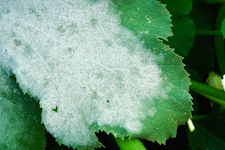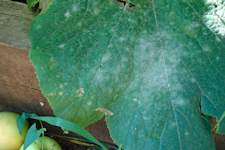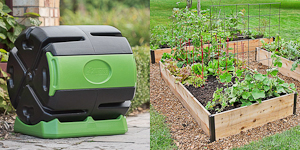- Home
- Common Plant Diseases
- Powdery Mildew
Powdery Mildew
Powdery mildew is a common plant disease that can be caused by several different species of fungi. It can attack many vegetable crops, but it especially seems to like zucchini, crookneck squash, cucumber and winter squash.
It also grows on peas, but since they are an earlier, cooler season
crop, they aren't affected as often. Other hosts are roses, apple or
pear trees, grapes, lawn grass and lilacs, which are often grown in the
landscape nearby the vegetable garden.
Powdery mildew appears as powdery-looking gray spots or patches, or can even take over whole leaves. It is fairly common and is one of the easiest-to-identify plant diseases.
Once it gets going, it is hard to stop it from taking over, and in my garden, it has sometimes covered my whole zucchini patch.
The fungus grows on the surface of the plant, but sends little rootlike structures down into the plant’s epithelial cells to suck nutrition. In severe outbreaks it will kill the affected leaf or bud of the plant.
How It Thrives
 Powdery Mildew on Squash Powdery Mildew on Squash |
 Another Afflicted Squash Leaf Another Afflicted Squash Leaf |
I live in Colorado, where the weather in the summer is often 85-100 degrees and dry. The fungus likes these conditions a lot, especially because we have to water frequently, which creates local high humidity around the plants.
I read John Jeavons' work decades ago and so was trained in the intensively-planted “living mulch” theory of "maximum production" in French-intensive raised beds. I no longer garden this way, having discovered that among other problems, it decreases airflow around the plants, making my zucchini especially vulnerable to the fungus.
Rainy weather is not the problem, but rather hot, still, dry conditions followed by a blast of high humidity, such as... when we water.
Powdery Mildew Control Measures
Since powdery mildew thrives in hot, dry conditions with high local humidity around the plant, the easiest way to control it is really to prevent it in the first place by depriving it of what it needs.
I used to water with overhead sprinklers, before dawn, in an attempt to let the plants dry off while it was still relatively cool in the morning. This was not a success, however, so I installed parallel surface driplines that now water at soil level.
I now also plant my zucchini plants in an open area of the garden, and leave plenty of space around them.
Another good prevention practice is to make and use actively aerated compost tea (really
microbial tea), which coats the leaves and soil with good microbes,
which will greatly increase your plants' disease resistance.
Powdery Mildew Treatments
Sulfur Spray Your local nursery will carry some powdery mildew treatments, most of which contain sulfur, which kills the fungus. Affected leaves will not usually recover, however. The spray just inhibits its spreading to other parts of the plant.
Be sure to check the label of whatever product you buy, because they are not all approved for use on vegetables (especially those containing triforine).
Neem oil can be an effective control, but must be used on a regular basis, and again, the affected leaves will generally not recover.
Dilute Yogurt Spray
This actually seems to kill the powdery mildew on the leaves. Mix up 1
Tablespoon of plain, unsweetened yogurt in a cup of water, put in a
spray bottle and spray the leaves daily after dusk, when it's cooling
off. (Actually, I use the thin watery liquid that pools in the space in
the yogurt left by the spoon. This is called whey, and is full of good
microbes.) My theory is that this works in similar way to aerobic
compost tea: the microbes in the yogurt outcompete the pathological
organisms. Raw milk also works well, although unless you own a milker or
a "herd share", access to raw milk is difficult.
Cornell Experimental Spray An article from our local Colorado State Extension Service reported that Cornell University was experimenting with a non-toxic homemade spray for powdery mildew control. It was made by combining:
- 1 Tablespoon baking soda
- 2 ½ Tablespoons light horticultural oil (Safers or Sunspray)
- 1 gallon of water
and spraying it on the affected plants. I have not tried this, and the article ended by saying “Use it at your own risk”. I second that, but offer it in the spirit of experimentation. If you make it, make sure the horticultural oil you use is recommended for use on food plants.
Powdery Mildew Best Practices
Do your best to control powdery mildew this year, but also help prevent getting it next year by doing good fall garden cleanup.
It is important to NOT put plants or plant parts that have been affected into the compost, because the spores of some species will overwinter and survive, even in a fairly hot composting operation.
Do a thorough garden cleanup in the fall, disposing of all affected plant material in the trash. Wash your hands and change your clothes before hauling your other crop wastes to the compost pile. No need to “share the joy” with next year’s plants.
Help share the skills and spread the joy
of organic, nutrient-dense vegetable gardening, and please...
~ Like us on Facebook ~
Thank you... and have fun in your garden!
Affiliate Disclaimer
This website contains affiliate links to a few quality products I can genuinely recommend. I am here to serve you, not to sell you, and I do not write reviews for income or recommend anything I would not use myself. If you make a purchase using an affiliate link here, I may earn a commission but this will not affect your price. My participation in these programs allows me to earn money that helps support this site. If you have comments, questions or concerns about the affiliate or advertising programs, please Contact Me.Contact Us Page



